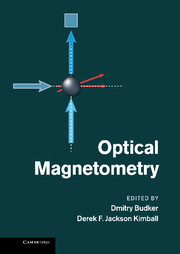Book contents
- Frontmatter
- Contents
- List of contributors
- Preface
- Part I Principles and techniques
- 1 General principles and characteristics of optical magnetometers
- 2 Quantum noise in atomic magnetometers
- 3 Quantum noise, squeezing, and entanglement in radiofrequency optical magnetometers
- 4 Mx and Mz magnetometers
- 5 Spin-exchange-relaxation-free (SERF) magnetometers
- 6 Optical magnetometry with modulated light
- 7 Microfabricated atomic magnetometers
- 8 Optical magnetometry with nitrogen-vacancy centers in diamond
- 9 Magnetometry with cold atoms
- 10 Helium magnetometers
- 11 Surface coatings for atomic magnetometry
- 12 Magnetic shielding
- Part II Applications
- Part III Broader impact
- Index
8 - Optical magnetometry with nitrogen-vacancy centers in diamond
from Part I - Principles and techniques
Published online by Cambridge University Press: 05 May 2013
- Frontmatter
- Contents
- List of contributors
- Preface
- Part I Principles and techniques
- 1 General principles and characteristics of optical magnetometers
- 2 Quantum noise in atomic magnetometers
- 3 Quantum noise, squeezing, and entanglement in radiofrequency optical magnetometers
- 4 Mx and Mz magnetometers
- 5 Spin-exchange-relaxation-free (SERF) magnetometers
- 6 Optical magnetometry with modulated light
- 7 Microfabricated atomic magnetometers
- 8 Optical magnetometry with nitrogen-vacancy centers in diamond
- 9 Magnetometry with cold atoms
- 10 Helium magnetometers
- 11 Surface coatings for atomic magnetometry
- 12 Magnetic shielding
- Part II Applications
- Part III Broader impact
- Index
Summary
Introduction
While atomic magnetometers can measure magnetic fields with exceptional sensitivity and without cryogenics, spin-altering collisions limit the sensitivity of sub-millimeter-scale sensors [1]. In order to probe magnetic fields with nanometer spatial resolution, magnetic measurements using superconducting quantum interference devices (SQUIDs) [2–4] as well as magnetic resonance force microscopes (MRFMs) [5–8] have been performed. However, the spatial resolution of the best SQUID sensors is still not better than a few hundred nanometers [9] and both sensors require cryogenic cooling to achieve high sensitivity, which limits the range of possible applications. A related challenge that cannot be met with existing technology is imaging weak magnetic fields over a wide field of view (millimeter scale and beyond) combined with sub-micron resolution and proximity to the signal source under ambient conditions.
Recently, a new technique has emerged for measuring magnetic fields at the nanometer scale, as well as for wide-field-of-view magnetic field imaging, based on optical detection of electron spin resonances of nitrogen-vacancy (NV) centers in diamond [10–12]. This system offers the possibility to detect magnetic fields with an unprecedented combination of spatial resolution and magnetic sensitivity [8, 12–15] in a wide range of temperatures (from 0 K to well above 300 K), opening up new frontiers in biological [10, 16, 17] and condensed-matter [10, 18, 19] research. Over the last few years, researchers have developed techniques for nanoscale magnetic imaging in bulk diamond [11, 12, 20] and in nanodiamonds [21–23] along with scanning probe techniques [10, 24].
- Type
- Chapter
- Information
- Optical Magnetometry , pp. 142 - 166Publisher: Cambridge University PressPrint publication year: 2013
- 5
- Cited by



